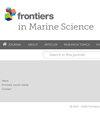Artificial clicks (Porpoise ALert) affect acoustic monitoring of harbour porpoises and their echolocation behaviour
IF 3
2区 生物学
Q1 MARINE & FRESHWATER BIOLOGY
引用次数: 0
Abstract
IntroductionIn 2021, a continuous acoustic monitoring programme was initiated in the Baltic Sea of Schleswig-Holstein to determine the occurrence and seasonal distribution of harbour porpoises. At the same time, fishers in this area applied acoustic devices (Porpoise ALert, PAL) generating artificial porpoise clicks to reduce bycatches in set-net fisheries. The underlying hypothesis was that signals from porpoise acoustic warning devices (PALs) might be misinterpreted by the click loggers (C-POD) as genuine porpoise clicks, potentially leading to an increase in detections. The study aimed to determine whether PALs were being recorded at the monitoring stations, and to identify effective methods for filtering out artificial signals.MethodsTherefore, we deployed an array of 11 C-PODs at distances between 50 and 350 m to a duty-cycled PAL in the middle over a period of 3 months. A sophisticated machine learning approach was employed that was able to discriminate natural porpoise signals from artificial PAL signals using the full click sequence parameters.ResultsThe trained algorithm showed remarkable efficiency in discriminating between artificial PAL signals and natural harbour porpoise clicks, demonstrating good sensitivity (99.74%) and accuracy (97.12%) in the test dataset.DiscussionThe consequences for compromised monitoring are significant, particularly in regions with low harbour porpoise densities, where artificial signals may influence the interpretation of diurnal and seasonal aspects of natural harbour porpoise behaviour, leading to misinterpretations. The effectiveness of management measures depends on the availability of reliable monitoring data, which is essential given the urgent need to improve the conservation of harbour porpoises, which are declining in the western Baltic Sea within the waters of Schleswig-Holstein. Finally, the study design was maximised to provide further information on PAL functionality and effectiveness as warning devices. The results revealed a reduction in the number of porpoise clicks during PAL operation, and changes in echolocation patterns characterised by increased minimum Inter-click-intervals (ICI), suggesting a shift from foraging or communication to orientation activity, and decreased maximum ICI, indicating enhanced long-range orientation. The function of these devices on echolocation behaviour remains therefore unclear, as it is not known whether they act solely as an alarm or rather as a deterrent.人工咔哒声(鼠海豚警报)影响港湾鼠海豚的声学监测及其回声定位行为
2021年,在石勒苏益格-荷尔斯泰因的波罗的海启动了一项持续的声学监测计划,以确定港口鼠海豚的发生和季节性分布。与此同时,该地区的渔民使用声学装置(鼠海豚警报,PAL)产生人工鼠海豚的声音,以减少设置渔网的副渔获量。潜在的假设是,海豚声音警报装置(PALs)发出的信号可能会被咔哒声记录器(C-POD)误解为海豚的真实咔哒声,从而可能导致探测到的海豚数量增加。该研究旨在确定监测站是否记录了pal,并确定过滤人工信号的有效方法。因此,在3个月的时间里,我们在距离50到350米的地方部署了11个c - pod阵列,中间是一个占空比PAL。采用了一种复杂的机器学习方法,能够使用完整的点击序列参数区分自然海豚信号和人工PAL信号。结果该算法对人工PAL信号和天然港鼠叫声的识别效率显著,在测试数据集上具有良好的灵敏度(99.74%)和准确率(97.12%)。讨论监测受损的后果是严重的,特别是在港鼠密度低的地区,在那里,人工信号可能影响对港鼠自然行为的日和季节方面的解释,导致误解。管理措施的有效性取决于能否获得可靠的监测数据,鉴于迫切需要改善对海港鼠海豚的养护,这是至关重要的。在石勒苏益格-荷尔斯泰因水域内的波罗的海西部,海港鼠海豚数量正在减少。最后,研究设计被最大化,以提供PAL作为预警装置的功能和有效性的进一步信息。结果表明,海豚在PAL操作过程中点击次数减少,回声定位模式发生变化,其特征是最小点击间隔(ICI)增加,表明海豚从觅食或交流活动转向定向活动,最大ICI减少,表明海豚的远程定向活动增强。因此,这些装置对回声定位行为的作用仍然不清楚,因为不知道它们是仅仅作为警报还是作为威慑。
本文章由计算机程序翻译,如有差异,请以英文原文为准。
求助全文
约1分钟内获得全文
求助全文
来源期刊

Frontiers in Marine Science
Agricultural and Biological Sciences-Aquatic Science
CiteScore
5.10
自引率
16.20%
发文量
2443
审稿时长
14 weeks
期刊介绍:
Frontiers in Marine Science publishes rigorously peer-reviewed research that advances our understanding of all aspects of the environment, biology, ecosystem functioning and human interactions with the oceans. Field Chief Editor Carlos M. Duarte at King Abdullah University of Science and Technology Thuwal is supported by an outstanding Editorial Board of international researchers. This multidisciplinary open-access journal is at the forefront of disseminating and communicating scientific knowledge and impactful discoveries to researchers, academics, policy makers and the public worldwide.
With the human population predicted to reach 9 billion people by 2050, it is clear that traditional land resources will not suffice to meet the demand for food or energy, required to support high-quality livelihoods. As a result, the oceans are emerging as a source of untapped assets, with new innovative industries, such as aquaculture, marine biotechnology, marine energy and deep-sea mining growing rapidly under a new era characterized by rapid growth of a blue, ocean-based economy. The sustainability of the blue economy is closely dependent on our knowledge about how to mitigate the impacts of the multiple pressures on the ocean ecosystem associated with the increased scale and diversification of industry operations in the ocean and global human pressures on the environment. Therefore, Frontiers in Marine Science particularly welcomes the communication of research outcomes addressing ocean-based solutions for the emerging challenges, including improved forecasting and observational capacities, understanding biodiversity and ecosystem problems, locally and globally, effective management strategies to maintain ocean health, and an improved capacity to sustainably derive resources from the oceans.
 求助内容:
求助内容: 应助结果提醒方式:
应助结果提醒方式:


